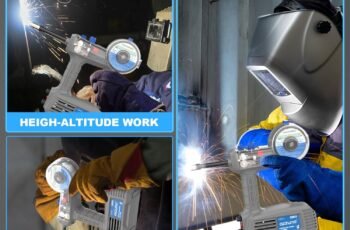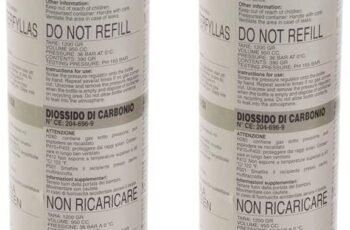Ad Blocker Detected
Our website is made possible by displaying online advertisements to our visitors. Please consider supporting us by disabling your ad blocker.
Taking care of your welding machine doesn’t have to be a daunting task. By establishing a routine maintenance schedule, you can ensure its longevity and optimal performance. Start with daily checks of oil, fuel levels, and connections. Weekly, focus on cleaning weld terminals and clearing debris. Pay attention to air filters and oil changes every 50–100 hours. Wondering how to spot those early warning signs and keep everything running smoothly? There’s more to explore.
Clean and Debris Management
When it comes to maintaining your welding machine, keeping it clean and managing debris are essential tasks. Establishing a regular cleaning schedule prevents debris accumulation. Use mechanical methods like brushes and scrapers for routine cleaning, while chemical solvents are effective for dissolving oils. For challenging areas, consider ultrasonic or steam cleaning. Regular cleaning not only enhances performance but also extends the lifespan of welding equipment. Always refer to manufacturer guidelines for specific cleaning intervals. Covering your equipment with protective tarps shields it from dust, and organized storage helps keep your workspace tidy. Apply rust-prevention sprays and segregate waste materials like metal scraps for proper recycling. Pre-clean workpieces using solvents to remove rust before welding. Safety is crucial—wear PPE, ensure good ventilation, and secure equipment during cleaning to protect against hazards.
Cable and Connection Inspections
As you maintain your welding machine, paying close attention to cable and connection inspections is crucial for both safety and performance.
Start by testing ground continuity to ensure proper earthing, as ground connections must carry full load current without resistance. Inspect power cords for cuts or fraying, and replace any damaged ones immediately. It is essential that welding and return leads are tightly connected via sockets or lugs to ensure reliable performance and safety.
Verify the plug-prong condition for straightness and intact ground pins, avoiding bent or corroded ones. Tighten cable-to-machine connections to prevent arcing or overheating. Confirm cables match the machine’s current capacity.
Secure electrode and return clamps without over-tightening. Inspect holders for rust, and connectors for wear, replacing compromised insulation.
Keep cables away from heat sources, and use industrial-grade plugs for power connections.
Cooling System Maintenance
A crucial aspect of extending your welding machine’s lifespan is diligent cooling system maintenance.
Start by inspecting cooling components. Check hoses and lines for blockages or leaks, and ensure heat exchangers are free from corrosion. Test cooling fans for proper airflow, and verify the coolant reservoir isn’t contaminated. Confirm the pump’s flow rate is correct. To further ensure system reliability, inspect cooling lines for kinks that could impede coolant flow.
Keep coolant levels up with manufacturer-approved fluids, and replace any degraded coolant. Don’t mix different coolants to avoid chemical issues. Inspect connections for leaks, tightening or replacing as needed, and prepare surfaces before reassembly.
Clean cooling fans and lubricate moving parts. Schedule regular maintenance, flush systems, clean heat exchangers, and replace filters to ensure optimal performance and longevity.
Storage and Environmental Considerations
Proper maintenance of a welding machine’s cooling system lays a strong foundation for its longevity, but it’s equally vital to consider how you store the equipment and its surrounding environment.
Store your welding machine in a dry, clean, and well-ventilated area to minimize moisture-induced corrosion and electronic damage. Avoid damp environments like basements to prevent rust and damage to internal components.
Before storing, clean equipment surfaces and inspect for damage, replacing or repairing any faulty parts. Detach consumables to avoid contamination and disconnect the power to prevent accidental activation. Use a custom-made cover to protect the machine from dust and debris, which can clog ventilation openings and cause overheating.
Ensure airflow to disperse residual heat. Keep machines separate from flammable materials, using fire-resistant containers and labeling storage zones clearly to mitigate hazards.
Install ventilation systems to capture pollutants.
Routine Maintenance Schedule
Keeping your welding machine in top condition requires a well-planned routine maintenance schedule.
Start with daily checks: monitor oil and fuel levels, clean or replace air filters, and inspect connections for damage. Calibrate equipment and report any spills immediately.
Weekly or monthly, purge debris, inspect hoses, and clean weld terminals. Check coolant levels and service wire feeds. Regular maintenance ensures equipment operates at peak performance, enhancing safety for users during welding operations.
Every 50–100 hours, replace air filter elements, tighten battery connections, and perform oil changes. Maintain the cooling system and check valve clearance.
At 200–500 hour intervals, replace fuel filters, clean spark arrestors, and repair cables.
Annually, perform full calibrations, replace regulators, and inspect components thoroughly.
Adhering to this schedule ensures your welding machine runs efficiently and safely.
Preventive Care Programs
To ensure your welding machine operates without hiccups, embrace a comprehensive preventive care program.
Begin with pre-use inspections by checking power connections and ensuring gas lines are secure and leak-free. Examine Tungsten electrodes for wear and verify filler wire stock levels.
Daily operational checks should include calibrating weld heads and monitoring shield gas flow. Replace worn consumables to maintain welding quality.
After operation, disconnect power, allow cooling, and vacuum internal components every six months. Coil gas hoses neatly and clean weld terminals with wire brushes.
Manage consumables proactively by tracking usage and storing them correctly.
Integrate maintenance with safety protocols by scheduling reviews during safety meetings and documenting activities for accountability. This approach keeps your equipment reliable.
Personnel Training and Safety Protocols
After establishing a solid preventive care program for your welding machines, it’s equally important to focus on personnel training and safety protocols.
Start with comprehensive safety education, covering risk assessments to identify fire hazards and health risks. Implement control measures like protective barriers and check ventilation before welding. Regularly inspect equipment, especially electrode holders and grounding systems. Update safety plans as conditions change.
Ensure PPE standards by mandating fire-resistant attire and respirators in poorly ventilated spaces. Helmets with UV/IR filters are essential for eye protection. Conduct PPE inspections frequently.
Position fire extinguishers nearby and have emergency protocols in place. Train workers on equipment operation, stressing manufacturer guidelines and “power off” rules.
Maintain regulatory compliance, scheduling audits, and posting warning signs to uphold safety standards.
Conclusion
To keep your welding machine in top shape, follow a regular maintenance routine. Clean debris and inspect cables and connections frequently. Don’t forget to maintain the cooling system and store the machine in a clean, dry space. Stick to a routine schedule for oil changes and air filter replacements. Implement preventive care programs and ensure all personnel are trained on safety protocols. By staying proactive, you’ll ensure your machine’s longevity and optimal performance.



